Online Classes Vs. Traditional Classes Essay
Online vs. in-person classes essay – introduction, online and traditional classes differences, works cited.
The article compares and contrasts online classes and traditional classes. Among the advantages of online classes are flexibility and convenience, while in-person classes offer a more structured learning environment. The author highlights that online lessons can be more cost-effective, although they lack support provided by live interactions. Overall, the online vs. traditional classes essay is very relevant today, and the choice depends on the individual student’s needs and preferences.
Modern technology has infiltrated the education sector and as a result, many college students now prefer taking online classes, as opposed to attending the traditional regular classes. This is because online classes are convenient for such students, and more so for those who have to both work and attend classes.
As such, online learning gives them the flexibility that they needed. In addition, online learning also gives an opportunity to students and professionals who would not have otherwise gone back to school to get the necessary qualifications. However, students who have enrolled for online learning do not benefit from the one-on-one interaction with their peers and teachers. The essay shall endeavor to examine the differences between online classes and the traditional classes, with a preference for the later.
Online classes mainly take place through the internet. As such, online classes lack the regular student teacher interaction that is common with traditional learning. On the other hand, learning in traditional classes involves direct interaction between the student and the instructors (Donovan, Mader and Shinsky 286).
This is beneficial to both the leaner and the instructors because both can be bale to establish a bond. In addition, student attending the traditional classroom often have to adhere to strict guidelines that have been established by the learning institution. As such, students have to adhere to the established time schedules. On the other hand, students attending online classes can learn at their own time and pace.
One advantage of the traditional classes over online classes is that students who are not disciplined enough may not be able to sail through successfully because there is nobody to push them around. With traditional classes however, there are rules to put them in check. As such, students attending traditional classes are more likely to be committed to their education (Donovan et al 286).
Another advantage of the traditional classes is all the doubts that students might be having regarding a given course content can be cleared by the instructor on the spot, unlike online learning whereby such explanations might not be as coherent as the student would have wished.
With the traditional classes, students are rarely provided with the course materials by their instructors, and they are therefore expected to take their own notes. This is important because they are likely to preserve such note and use them later on in their studies. In contrast, online students are provided with course materials in the form of video or audio texts (Sorenson and Johnson 116).
They can also download such course materials online. Such learning materials can be deleted or lost easily compared with handwritten class notes, and this is a risk. Although the basic requirements for a student attending online classes are comparatively les in comparison to students attending traditional classes, nonetheless, it is important to note that online students are also expected to be internet savvy because all learning takes place online.
This would be a disadvantage for the regular student; only that internet savvy is not a requirement. Students undertaking online learning are likely to be withdrawn because they hardly interact one-on-one with their fellow online students or even their instructors. The only form of interaction is online. As such, it becomes hard for them to develop a special bond with other students and instructors. With traditional learning however, students have the freedom to interact freely and this helps to strengthen their existing bond.
Online learning is convenient and has less basic requirements compared with traditional learning. It also allows learners who would have ordinarily not gone back to school to access an education. However, online students do not benefit from a close interaction with their peers and instructors as do their regular counterparts. Also, regular students can engage their instructors more easily and relatively faster in case they want to have certain sections of the course explained, unlike online students.
Donovan, Judy, Mader, Cynthia and Shinsky, John. Constructive student feedback: Online vs. traditional course evaluations. Journal of Interactive Online Learning , 5.3(2006): 284-292.
Sorenson, Lynn, and Johnson, Trav. Online Student Ratings of Instructions . San Francisco: Jossey Bass, 2003. Print.
- Walmart Workplace Aspects Analysis
- Organizational Behavior and Workplace Conflicts
- The Value of In-Person Human Interaction
- Principles Application in E-Learning
- Cambourne’s Conditions of Learning
- Concept of Transformative Learning in Modern Education
- Podcasts as an Education Tool
- Wikis as an Educational Tool
- Chicago (A-D)
- Chicago (N-B)
IvyPanda. (2019, April 25). Online Classes Vs. Traditional Classes Essay. https://ivypanda.com/essays/online-classes-vs-traditional-classes-essay/
"Online Classes Vs. Traditional Classes Essay." IvyPanda , 25 Apr. 2019, ivypanda.com/essays/online-classes-vs-traditional-classes-essay/.
IvyPanda . (2019) 'Online Classes Vs. Traditional Classes Essay'. 25 April.
IvyPanda . 2019. "Online Classes Vs. Traditional Classes Essay." April 25, 2019. https://ivypanda.com/essays/online-classes-vs-traditional-classes-essay/.
1. IvyPanda . "Online Classes Vs. Traditional Classes Essay." April 25, 2019. https://ivypanda.com/essays/online-classes-vs-traditional-classes-essay/.
Bibliography
IvyPanda . "Online Classes Vs. Traditional Classes Essay." April 25, 2019. https://ivypanda.com/essays/online-classes-vs-traditional-classes-essay/.

Rating Content
The 7 biggest differences between online learning vs classroom learning.

Table of contents
Share this article.
Online learning vs classroom learning is two popular options for acquiring knowledge and skills.
While both have their advantages and disadvantages, each approach offers a unique learning experience.
As technology continues to advance, online learning has become an increasingly popular alternative to traditional classroom learning.
In this comprehensive guide, we will explore the seven biggest differences between online learning vs classroom learning, including factors such as flexibility, cost, interaction, and more.
Whether you're a student or a teacher, understanding the differences between these two approaches can help you choose the best learning method for your needs.
So what are we waiting for? Let’s dive into all that you need to know about online learning vs classroom learning.
Advantages And Disadvantages Of Online Learning

Let’s have a look at some of the advantages and disadvantages of online learning.
Advantages of Online Learning:
1. flexibility.
It allows learners to study at their own pace and on their schedule, making it an ideal option for those with busy lifestyles or other commitments.
2. Cost-Effective
Online courses are often less expensive than traditional classroom-based courses, making education more accessible to a wider range of learners.
3. Accessibility
It is available to anyone with an internet connection, regardless of geographic location or physical disabilities.
4. Personalized Learning
Online courses often offer personalized learning experiences, allowing learners to focus on their areas of interest or weaknesses.
Disadvantages of Online Learning
1. limited interaction.
It lacks the face-to-face interaction and socialization opportunities of traditional classroom learning, which may be a disadvantage for some learners.
2. Technical Issues
Technical difficulties such as internet connectivity issues, software glitches, or hardware malfunctions can disrupt the learning experience.
3. Self-Motivation
It requires a high degree of self-discipline and self-motivation, which may be challenging for some learners who require more structured learning environments.
4. Lack Of Feedback
It may offer limited feedback opportunities from instructors or peers, which can make it difficult for learners to gauge their progress and receive constructive criticism.
Now that we have discussed the advantages and disadvantages of online learning, let’s move on to those of classroom learning.
Advantages And Disadvantages Of Classroom Learning

Advantages of Classroom Learning:
1. face-to-face interaction.
Classroom learning allows learners to engage in face-to-face interaction with their peers and instructors, facilitating collaboration and the exchange of ideas.
2. Structured Learning Environment
It provides a structured learning environment that may be beneficial for learners who require a more hands-on, guided approach to learning.
3. Immediate Feedback
It offers immediate feedback opportunities from instructors and peers, enabling learners to gauge their progress and receive constructive criticism.
4. Enhanced Socialization
It offers socialization opportunities that may help learners develop important social skills and networks.
Disadvantages of Classroom Learning:
1. limited flexibility.
Classroom learning may be less flexible than online learning, requiring learners to attend classes at specific times and locations.
2. Higher Cost
It may be more expensive than online learning due to costs associated with facilities, materials, and travel.
3. Distractions
It may be subject to distractions such as noise, disruptions, or interruptions, which can disrupt the learning experience.
4. Limited Customization
It may offer limited customization options, making it difficult for learners to focus on their specific areas of interest or weaknesses.
Online Learning Vs Classroom Learning

Let’s have a look at the top 7 differences between online learning vs classroom learning.
1. Learning Environment
The learning environment is one of the most significant differences between online learning and classroom learning.
Classroom learning takes place in a physical classroom, where students are present in-person with their teachers and peers.
The classroom provides a structured environment, which helps students stay on task, focus on their work, and receive immediate feedback from the teacher.
In contrast, online learning takes place in a virtual classroom, where students connect to a course via their computer or mobile device.
Online learners can access their course materials and assignments from anywhere, and at any time, making it a more flexible and convenient option.
2. Interaction
Another significant difference between online and classroom learning is the level of interaction between students and instructors .
In a classroom setting, students have the opportunity to interact with their peers and instructors face-to-face, which can help build strong relationships and a sense of community.
Classroom learning also allows for immediate feedback from the instructor, which can be very beneficial to students.
Online learning, on the other hand, relies on virtual communication, which can be less personal and less engaging than face-to-face interaction.
3. Schedule
One of the major benefits of online learning is the flexibility it offers.
Online courses are self-paced, which means that students can study when it's most convenient for them.
This makes it easier for students to balance their studies with work, family, and other commitments.
In contrast, classroom learning follows a set schedule, with specific times and locations for classes. This can be a challenge for students who have busy schedules or who live far from the school or university.
4. Teaching Methodology
Classroom learning and online learning differ in their teaching methodology. In a classroom setting, teachers use lectures, discussions, and group work to deliver the course material.
This can be very effective for students who learn best through social interaction and discussion. In contrast, online learning is more self-directed, with students responsible for reading the course materials and completing assignments on their own.
This can be beneficial for students who are more self-motivated or who prefer to work at their own pace.
Cost is another major difference between online and classroom learning.
Online courses are often less expensive than classroom courses, as there are fewer costs associated with facilities, materials, and travel.
This makes online learning a more accessible option for many students.
In contrast, classroom learning can be quite expensive, as students must pay for tuition, textbooks, transportation, and other expenses.
6. Technology
Technology plays a critical role in online learning, as students must have access to a computer and internet connection to participate in the course.
Online courses often incorporate a variety of technology tools, such as videos, podcasts, interactive quizzes, and online discussion forums.
In contrast, classroom learning may also use technology, but to a lesser extent.
7. Learning Style
Finally, online and classroom learning may be better suited to different learning styles.
Classroom learning may be more beneficial for students who learn best through social interaction and discussion, while online learning may be more effective for students who prefer self-directed learning and need to work at their own pace.
Ultimately, the best approach to learning will depend on each student's unique learning style, preferences, and circumstances.
Learn With Oreed
Experience enhanced learning capabilities in your workplace with Oreed's all-in-one platform.
- Gain a 360-degree understanding of your employees and better gauge their training needs.
- Oreed offers tailor-made training and courses to fit your organization's specific needs.
- You can measure the effectiveness of your training/courses with the platform's impact assessment feature.
So what are you waiting for? Book a demo with Oreed today to find out more.
Promote lifelong learning through Oreed by experiencing the most powerful all-in-one training and development intelligent platform that streamlines all your organization's learning, training, and development activities in one place.
Final Thoughts
In conclusion, online learning vs classroom learning has its advantages and disadvantages.
While online learning offers flexibility and convenience, classroom learning provides face-to-face interaction and a structured learning environment.
Ultimately, the choice between the two depends on individual preferences and learning styles.
It is important to carefully consider the differences between online learning and classroom learning and choose the approach that best fits your needs and goals.
As technology continues to advance, the line between these two learning modes will likely continue to blur, creating even more options for learners in the future.
1. What is collaborative online learning?
Collaborative online learning is an approach to education that emphasizes collaborative group work and online communication tools to facilitate learning .
It involves students working together in virtual environments to complete learning activities and achieve shared learning goals.
Collaborative online learning allows students to engage in collaborative projects and activities regardless of their physical location, creating a sense of community and encouraging participation and engagement.
This approach can be implemented in various learning contexts, from traditional classroom settings to fully online courses, and is aimed at fostering critical thinking, problem-solving, communication, and teamwork skills.
2. What are some interesting facts about online learning?
Here are some interesting facts about online learning:
- Online courses are often more affordable than traditional in-person courses.
- It allows for greater flexibility and convenience, allowing students to learn at their own pace and on their schedule.
- Another fact about online learning is that online courses can be accessed from anywhere with an internet connection, making education more accessible to a wider audience.
- It is just as effective, and in some cases more effective, than traditional in-person learning.
- It often offers a wide range of multimedia content, including videos, animations, and interactive simulations, which can enhance the learning experience.
Subscribe to our weekly email newsletter
Stay updated with the latest e-learning news and receive all the essential updates regarding the Oreed platform.
Please fix the following errors:
keep reading
![compare and contrast online learning vs traditional classroom learning essay Learning Experience Platform Market Size [2024]](https://oreed.org/cdn/1619638329_6089b83993722/1658391437_62d90b8d45216/1658391471_62d90baf0898f/1702465413_65798f85e1464/1702465413_65798f85e1078.jpeg)
Learning Experience Platform Market Size [2024]
Explore our in-depth analysis of the learning experience platform market size, trends, and forecasts for 2024. Dive into our expert LXP market insights.
![compare and contrast online learning vs traditional classroom learning essay What is a Learning Experience Platform [2024 Full Guide]](https://oreed.org/cdn/1619638329_6089b83993722/1658391437_62d90b8d45216/1658391471_62d90baf0898f/1702464014_65798a0ecf990/1702464014_65798a0ecf60a.jpeg)
What is a Learning Experience Platform [2024 Full Guide]
Learning Experience Platforms (LXPs) have revolutionized the field of learning and development, providing learners with innovative and personalized learning experiences.

AI In Recruitment
AI in recruitment enhances efficiency without replacing human recruiters. Discover Oreed for advanced employee development.
Supporting your growth every step of the way
Our support superheroes are a click away to help you get the most out of oreed.com, so you can focus on working without limits.
Support anytime, anywhere

Welcome to your new training intelligent platform
unlock your organization's potential and prepare to become a global leader of the future
A Comparison of Student Learning Outcomes: Online Education vs. Traditional Classroom Instruction
Despite the prevalence of online learning today, it is often viewed as a less favorable option when compared to the traditional, in-person educational experience. Criticisms of online learning come from various sectors, like employer groups, college faculty, and the general public, and generally includes a lack of perceived quality as well as rigor. Additionally, some students report feelings of social isolation in online learning (Protopsaltis & Baum, 2019).
In my experience as an online student as well as an online educator, online learning has been just the opposite. I have been teaching in a fully online master’s degree program for the last three years and have found it to be a rich and rewarding experience for students and faculty alike. As an instructor, I have felt more connected to and engaged with my online students when compared to in-person students. I have also found that students are actively engaged with course content and demonstrate evidence of higher-order thinking through their work. Students report high levels of satisfaction with their experiences in online learning as well as the program overall as indicated in their Student Evaluations of Teaching (SET) at the end of every course. I believe that intelligent course design, in addition to my engagement in professional development related to teaching and learning online, has greatly influenced my experience.
In an article by Wiley Education Services, authors identified the top six challenges facing US institutions of higher education, and include:
- Declining student enrollment
- Financial difficulties
- Fewer high school graduates
- Decreased state funding
- Lower world rankings
- Declining international student enrollments
Of the strategies that institutions are exploring to remedy these issues, online learning is reported to be a key focus for many universities (“Top Challenges Facing US Higher Education”, n.d.).
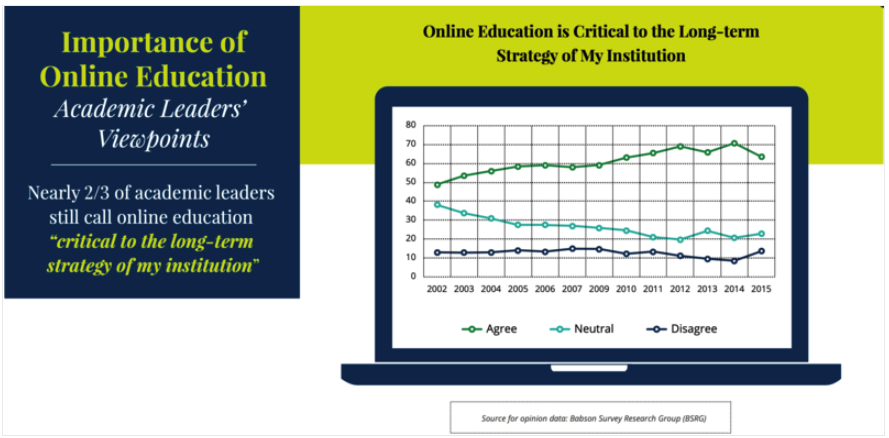
Babson Survey Research Group, 2016, [PDF file].
Some of the questions I would like to explore in further research include:
- What factors influence engagement and connection in distance education?
- Are the learning outcomes in online education any different than the outcomes achieved in a traditional classroom setting?
- How do course design and instructor training influence these factors?
- In what ways might educational technology tools enhance the overall experience for students and instructors alike?
In this literature review, I have chosen to focus on a comparison of student learning outcomes in online education versus the traditional classroom setting. My hope is that this research will unlock the answers to some of the additional questions posed above and provide additional direction for future research.
Online Learning Defined
According to Mayadas, Miller, and Sener (2015), online courses are defined by all course activity taking place online with no required in-person sessions or on-campus activity. It is important to note, however, that the Babson Survey Research Group, a prominent organization known for their surveys and research in online learning, defines online learning as a course in which 80-100% occurs online. While this distinction was made in an effort to provide consistency in surveys year over year, most institutions continue to define online learning as learning that occurs 100% online.
Blended or hybrid learning is defined by courses that mix face to face meetings, sessions, or activities with online work. The ratio of online to classroom activity is often determined by the label in which the course is given. For example, a blended classroom course would likely include more time spent in the classroom, with the remaining work occurring outside of the classroom with the assistance of technology. On the other hand, a blended online course would contain a greater percentage of work done online, with some required in-person sessions or meetings (Mayadas, Miller, & Sener, 2015).
A classroom course (also referred to as a traditional course) refers to course activity that is anchored to a regular meeting time.
Enrollment Trends in Online Education
There has been an upward trend in the number of postsecondary students enrolled in online courses in the U.S. since 2002. A report by the Babson Survey Research Group showed that in 2016, more than six million students were enrolled in at least one online course. This number accounted for 31.6% of all college students (Seaman, Allen, & Seaman, 2018). Approximately one in three students are enrolled in online courses with no in-person component. Of these students, 47% take classes in a fully online program. The remaining 53% take some, but not all courses online (Protopsaltis & Baum, 2019).

(Seaman et al., 2016, p. 11)
Perceptions of Online Education
In a 2016 report by the Babson Survey Research Group, surveys of faculty between 2002-2015 showed approval ratings regarding the value and legitimacy of online education ranged from 28-34 percent. While numbers have increased and decreased over the thirteen-year time frame, faculty approval was at 29 percent in 2015, just 1 percent higher than the approval ratings noted in 2002 – indicating that perceptions have remained relatively unchanged over the years (Allen, Seaman, Poulin, & Straut, 2016).
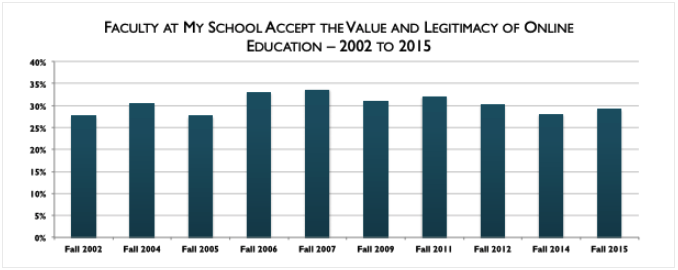
(Allen, I.E., Seaman, J., Poulin, R., Taylor Strout, T., 2016, p. 26)
In a separate survey of chief academic officers, perceptions of online learning appeared to align with that of faculty. In this survey, leaders were asked to rate their perceived quality of learning outcomes in online learning when compared to traditional in-person settings. While the percentage of leaders rating online learning as “inferior” or “somewhat inferior” to traditional face-to-face courses dropped from 43 percent to 23 percent between 2003 to 2012, the number rose again to 29 percent in 2015 (Allen, Seaman, Poulin, & Straut, 2016).
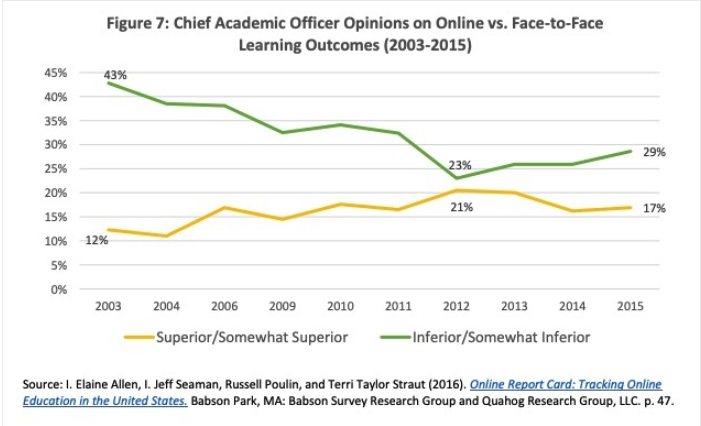
Faculty and academic leaders in higher education are not alone when it comes to perceptions of inferiority when compared to traditional classroom instruction. A 2013 Gallop poll assessing public perceptions showed that respondents rated online education as “worse” in five of the seven categories seen in the table below.
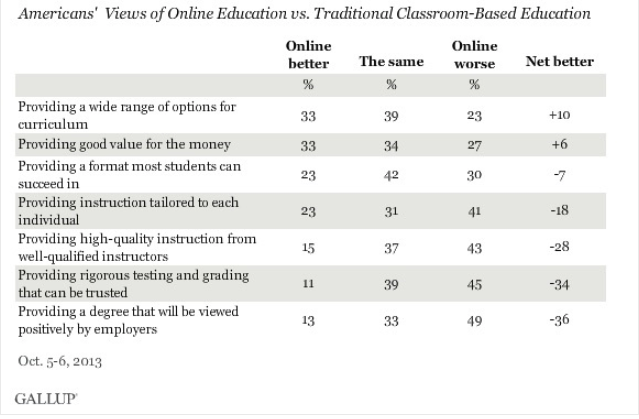
(Saad, L., Busteed, B., and Ogisi, M., 2013, October 15)
In general, Americans believed that online education provides both lower quality and less individualized instruction and less rigorous testing and grading when compared to the traditional classroom setting. In addition, respondents also thought that employers would perceive a degree from an online program less positively when compared to a degree obtained through traditional classroom instruction (Saad, Busteed, & Ogisi, 2013).
Student Perceptions of Online Learning
So what do students have to say about online learning? In Online College Students 2015: Comprehensive Data on Demands and Preferences, 1500 college students who were either enrolled or planning to enroll in a fully online undergraduate, graduate, or certificate program were surveyed. 78 percent of students believed the academic quality of their online learning experience to be better than or equal to their experiences with traditional classroom learning. Furthermore, 30 percent of online students polled said that they would likely not attend classes face to face if their program were not available online (Clienfelter & Aslanian, 2015). The following video describes some of the common reasons why students choose to attend college online.
How Online Learning Affects the Lives of Students ( Pearson North America, 2018, June 25)
In a 2015 study comparing student perceptions of online learning with face to face learning, researchers found that the majority of students surveyed expressed a preference for traditional face to face classes. A content analysis of the findings, however, brought attention to two key ideas: 1) student opinions of online learning may be based on “old typology of distance education” (Tichavsky, et al, 2015, p.6) as opposed to actual experience, and 2) a student’s inclination to choose one form over another is connected to issues of teaching presence and self-regulated learning (Tichavsky et al, 2015).
Student Learning Outcomes
Given the upward trend in student enrollment in online courses in postsecondary schools and the steady ratings of the low perceived value of online learning by stakeholder groups, it should be no surprise that there is a large body of literature comparing student learning outcomes in online classes to the traditional classroom environment.
While a majority of the studies reviewed found no significant difference in learning outcomes when comparing online to traditional courses (Cavanaugh & Jacquemin, 2015; Kemp & Grieve, 2014; Lyke & Frank 2012; Nichols, Shaffer, & Shockey, 2003; Stack, 2015; Summers, Waigandt, & Whittaker, 2005), there were a few outliers. In a 2019 report by Protopsaltis & Baum, authors confirmed that while learning is often found to be similar between the two mediums, students “with weak academic preparation and those from low-income and underrepresented backgrounds consistently underperform in fully-online environments” (Protopsaltis & Baum, 2019, n.p.). An important consideration, however, is that these findings are primarily based on students enrolled in online courses at the community college level – a demographic with a historically high rate of attrition compared to students attending four-year institutions (Ashby, Sadera, & McNary, 2011). Furthermore, students enrolled in online courses have been shown to have a 10 – 20 percent increase in attrition over their peers who are enrolled in traditional classroom instruction (Angelino, Williams, & Natvig, 2007). Therefore, attrition may be a key contributor to the lack of achievement seen in this subgroup of students enrolled in online education.
In contrast, there were a small number of studies that showed that online students tend to outperform those enrolled in traditional classroom instruction. One study, in particular, found a significant difference in test scores for students enrolled in an online, undergraduate business course. The confounding variable, in this case, was age. Researchers found a significant difference in performance in nontraditional age students over their traditional age counterparts. Authors concluded that older students may elect to take online classes for practical reasons related to outside work schedules, and this may, in turn, contribute to the learning that occurs overall (Slover & Mandernach, 2018).
In a meta-analysis and review of online learning spanning the years 1996 to 2008, authors from the US Department of Education found that students who took all or part of their classes online showed better learning outcomes than those students who took the same courses face-to-face. In these cases, it is important to note that there were many differences noted in the online and face-to-face versions, including the amount of time students spent engaged with course content. The authors concluded that the differences in learning outcomes may be attributed to learning design as opposed to the specific mode of delivery (Means, Toyoma, Murphy, Bakia, Jones, 2009).
Limitations and Opportunities
After examining the research comparing student learning outcomes in online education with the traditional classroom setting, there are many limitations that came to light, creating areas of opportunity for additional research. In many of the studies referenced, it is difficult to determine the pedagogical practices used in course design and delivery. Research shows the importance of student-student and student-teacher interaction in online learning, and the positive impact of these variables on student learning (Bernard, Borokhovski, Schmid, Tamim, & Abrami, 2014). Some researchers note that while many studies comparing online and traditional classroom learning exist, the methodologies and design issues make it challenging to explain the results conclusively (Mollenkopf, Vu, Crow, & Black, 2017). For example, some online courses may be structured in a variety of ways, i.e. self-paced, instructor-led and may be classified as synchronous or asynchronous (Moore, Dickson-Deane, Galyan, 2011)
Another gap in the literature is the failure to use a common language across studies to define the learning environment. This issue is explored extensively in a 2011 study by Moore, Dickson-Deane, and Galyan. Here, the authors examine the differences between e-learning, online learning, and distance learning in the literature, and how the terminology is often used interchangeably despite the variances in characteristics that define each. The authors also discuss the variability in the terms “course” versus “program”. This variability in the literature presents a challenge when attempting to compare one study of online learning to another (Moore, Dickson-Deane, & Galyan, 2011).
Finally, much of the literature in higher education focuses on undergraduate-level classes within the United States. Little research is available on outcomes in graduate-level classes as well as general information on student learning outcomes and perceptions of online learning outside of the U.S.
As we look to the future, there are additional questions to explore in the area of online learning. Overall, this research led to questions related to learning design when comparing the two modalities in higher education. Further research is needed to investigate the instructional strategies used to enhance student learning, especially in students with weaker academic preparation or from underrepresented backgrounds. Given the integral role that online learning is expected to play in the future of higher education in the United States, it may be even more critical to move beyond comparisons of online versus face to face. Instead, choosing to focus on sound pedagogical quality with consideration for the mode of delivery as a means for promoting positive learning outcomes.
Allen, I.E., Seaman, J., Poulin, R., & Straut, T. (2016). Online Report Card: Tracking Online Education in the United States [PDF file]. Babson Survey Research Group. http://onlinelearningsurvey.com/reports/onlinereportcard.pdf
Angelino, L. M., Williams, F. K., & Natvig, D. (2007). Strategies to engage online students and reduce attrition rates. The Journal of Educators Online , 4(2).
Ashby, J., Sadera, W.A., & McNary, S.W. (2011). Comparing student success between developmental math courses offered online, blended, and face-to-face. Journal of Interactive Online Learning , 10(3), 128-140.
Bernard, R.M., Borokhovski, E., Schmid, R.F., Tamim, R.M., & Abrami, P.C. (2014). A meta-analysis of blended learning and technology use in higher education: From the general to the applied. Journal of Computing in Higher Education , 26(1), 87-122.
Cavanaugh, J.K. & Jacquemin, S.J. (2015). A large sample comparison of grade based student learning outcomes in online vs. face-fo-face courses. Journal of Asynchronous Learning Network, 19(2).
Clinefelter, D. L., & Aslanian, C. B. (2015). Online college students 2015: Comprehensive data on demands and preferences. https://www.learninghouse.com/wp-content/uploads/2017/09/OnlineCollegeStudents2015.pdf
Golubovskaya, E.A., Tikhonova, E.V., & Mekeko, N.M. (2019). Measuring learning outcome and students’ satisfaction in ELT (e-learning against conventional learning). Paper presented the ACM International Conference Proceeding Series, 34-38. Doi: 10.1145/3337682.3337704
Kemp, N. & Grieve, R. (2014). Face-to-face or face-to-screen? Undergraduates’ opinions and test performance in classroom vs. online learning. Frontiers in Psychology , 5. Doi: 10.3389/fpsyg.2014.01278
Lyke, J., & Frank, M. (2012). Comparison of student learning outcomes in online and traditional classroom environments in a psychology course. (Cover story). Journal of Instructional Psychology , 39(3/4), 245-250.
Mayadas, F., Miller, G. & Senner, J. Definitions of E-Learning Courses and Programs Version 2.0. Online Learning Consortium. https://onlinelearningconsortium.org/updated-e-learning-definitions-2/
Means, B., Toyama, Y., Murphy, R., Bakia, M., & Jones, K. (2010). Evaluation of evidence-based practices in online learning: A meta-analysis and review of online learning studies. US Department of Education. https://www2.ed.gov/rschstat/eval/tech/evidence-based-practices/finalreport.pdf
Mollenkopf, D., Vu, P., Crow, S, & Black, C. (2017). Does online learning deliver? A comparison of student teacher outcomes from candidates in face to face and online program pathways. Online Journal of Distance Learning Administration. 20(1).
Moore, J.L., Dickson-Deane, C., & Galyan, K. (2011). E-Learning, online learning, and distance learning environments: Are they the same? The Internet and Higher Education . 14(2), 129-135.
Nichols, J., Shaffer, B., & Shockey, K. (2003). Changing the face of instruction: Is online or in-class more effective? College & Research Libraries , 64(5), 378–388. https://doi-org.proxy2.library.illinois.edu/10.5860/crl.64.5.378
Parsons-Pollard, N., Lacks, T.R., & Grant, P.H. (2008). A comparative assessment of student learning outcomes in large online and traditional campus based introduction to criminal justice courses. Criminal Justice Studies , 2, 225-239.
Pearson North America. (2018, June 25). How Online Learning Affects the Lives of Students . YouTube. https://www.youtube.com/watch?v=mPDMagf_oAE
Protopsaltis, S., & Baum, S. (2019). Does online education live up to its promise? A look at the evidence and implications for federal policy [PDF file]. http://mason.gmu.edu/~sprotops/OnlineEd.pdf
Saad, L., Busteed, B., & Ogisi, M. (October 15, 2013). In U.S., Online Education Rated Best for Value and Options. https://news.gallup.com/poll/165425/online-education-rated-best-value-options.aspx
Stack, S. (2015). Learning Outcomes in an Online vs Traditional Course. International Journal for the Scholarship of Teaching and Learning , 9(1).
Seaman, J.E., Allen, I.E., & Seaman, J. (2018). Grade Increase: Tracking Distance Education in the United States [PDF file]. Babson Survey Research Group. http://onlinelearningsurvey.com/reports/gradeincrease.pdf
Slover, E. & Mandernach, J. (2018). Beyond Online versus Face-to-Face Comparisons: The Interaction of Student Age and Mode of Instruction on Academic Achievement. Journal of Educators Online, 15(1) . https://files.eric.ed.gov/fulltext/EJ1168945.pdf
Summers, J., Waigandt, A., & Whittaker, T. (2005). A Comparison of Student Achievement and Satisfaction in an Online Versus a Traditional Face-to-Face Statistics Class. Innovative Higher Education , 29(3), 233–250. https://doi-org.proxy2.library.illinois.edu/10.1007/s10755-005-1938-x
Tichavsky, L.P., Hunt, A., Driscoll, A., & Jicha, K. (2015). “It’s just nice having a real teacher”: Student perceptions of online versus face-to-face instruction. International Journal for the Scholarship of Teaching and Learning. 9(2).
Wiley Education Services. (n.d.). Top challenges facing U.S. higher education. https://edservices.wiley.com/top-higher-education-challenges/
July 17, 2020
Online Learning
college , distance education , distance learning , face to face , higher education , online learning , postsecondary , traditional learning , university , virtual learning
Leave a Reply Cancel reply
Your email address will not be published. Required fields are marked *
Save my name, email, and website in this browser for the next time I comment.
© 2024 — Powered by WordPress
Theme by Anders Noren — Up ↑

Tips for Online Students , Tips for Students
Online Learning vs Classroom Learning: Online or Traditional Classes?
Updated: July 19, 2022
Published: September 4, 2019

Trying to decide between online learning vs traditional classroom learning can be extremely tricky. On the one hand, it’s 2019 and most of us have the technology in our pockets to access information on-the-go, so why would we commit to a campus college experience, that requires us to go to the same place every week for several years?
Yet on the other hand, there’s something magical about enrolling in college, buying a new backpack and heading onto campus with armfuls of books, and maybe a packed social schedule. It sounds romantic, it feels authentic, and it can bring out the academic in even the least scholarly of us.

Photo by Brooke Cagle on Unsplash
But what’s the best route to take? In this article, we compare and contrast some of the pros and cons of online vs classroom learning, to help you make an informed decision about what lies ahead.
Online Learning: Advantages
One of the biggest advantages of online learning is that you can study from anywhere. Tropical beach? From your bed? Staff room on your break at work? As long as you have an internet connection or a quiet room, you can learn from your laptop. You don’t need to spend time commuting every day, or re-locate your entire life to a new area. This could save you considerable amounts of money and stress in the long run, so it’s definitely an advantage to consider.
Online learning is also more accessible. Entry requirements are often more flexible, because online colleges can accommodate higher student numbers per course. Institutions like University of the People allow people to get a tuition-free, American accredited education , regardless of where they are in the world, allowing students to save money whilst gaining an all-important, reputable degree.
Online learning requires daily interaction with technology, from laptops to live-streamed lectures. So even without you realising it, you’ll be developing your technical literacy. This is a great transferable skill which will hold you in good stead for the future.
Another added bonus of online learning is less peer pressure from other students. You’ll be free to follow your own schedule and you won’t need to worry about what other students think of your thoughts or learning pace, because your learning experience will be more private, unless you choose to talk about it on course forums or social media, of course!
Online learning also costs less than traditional classroom-based experiences . A recent study by education analyst Ed Vosganian found that an undergraduate online degree could cost 50% less than an undergraduate on-campus course. Using statistics from a school in Florida, the study found that campus learning can cost $42,768 per year, whilst online learning can cost just $21,100, when extra costs like textbooks and accommodation are taken into account.
Similarly, a 2018 study by Arizona State University , commissioned by the Melinda and Bill Gates Foundation , looked carefully at the return on investment of online courses at traditional universities. The study found that “savings for online courses ranged from $12 to $66 per credit hour, a difference of from 3 percent to 50 percent of the average credit hour costs.”
This suggests that you really can save time, money and stress from studying online, with an institution that has the infrastructure to support you on your learning journey.
Online Learning: Disadvantages

Photo by Headway on Unsplash
On the flip-side, all this flexibility and independence means you need to be self-motivated to get results. Studying online means you will have less social interaction with other students and teachers, so there’s a greater possibility for the course to feel isolating.
However, you can counter this by using whatever resources your chosen institution makes available. For example, with degrees from University of the People, an online support system and regular interaction with course tutors means you’re never alone. Facebook and other social networks now mean you can connect with other online learners easily.
Another disadvantage to consider is that not all majors are available. Courses in business administration, computer science, and health science are readily available online, but if you want to deep-dive into hands-on courses like music or art, you may not be able to do this with an entirely online degree. Change is happening, but not all institutions have made all of their courses available online yet.
It can also be frustrating if you don’t understand something and online resources can’t help — sometimes it’s just nice to be able to pop in to see your course tutor during office hours, or to seek help from fellow students in the campus library or computer room.
You can also feel increased pressure to remember you are a student and it is up to you to get your work done. No one else is going to remind you, because your degree will take place inside your laptop (and your mind!) and won’t be immediately visible to other people you meet on a daily basis.
Traditional Learning: Advantages
Traditional classroom learning gives your life a structure and routine. With classes taking place at set times and the requirement to meet deadlines and attend classes face to face, it can help you establish discipline. This, of course, is a very useful transferable skill that employees will value when you graduate, so getting used to the ebb and flow of classroom life could hold you in good stead for the future.
You’ll also have continuous interaction with students and teachers. Even if it’s just a few hours per week, you’ll have a schedule that tells you exactly where and when you need to be each semester, and this routine can help you move forward with your studies and stay psychologically balanced.
It’s also well known that memories are made as you study. As a classroom learner, you can throw yourself into college life, whether that means joining the football team, taking part in a play or campaigning with other students for good causes that you believe in. It’s all available on campus, which could give your confidence and social life a real boost. It’ll certainly make learning more fun!
Traditional learning can also allow you to get a degree from a college that’s been around for longer. Studying at an “Ivy League” college in the US, for example, can feel more comforting, because you feel like you’re joining an established community of alumni. In reality, this may not actually make your degree any more useful, but the feeling that you’re joining a centuries’ old tradition can be reassuring anyway.
Traditional Learning: Disadvantages
Punctuality and attendance are important to campus universities. If you’re late or absent, it can work against you as your scores can be lowered to reflect this. Equally, if you are required to present something face-to-face and you don’t make a good impression, your mark may be lower. Traditional learning is more immediate — you won’t have as much time to prepare your responses, as a tutor could throw something at you in a seminar and expect you to respond accordingly.
Equally, if you drop-out or postpone your studies half-way through, perhaps because it’s just too much to juggle right now, you can lose a lot of money as campus based courses are considerably more expensive than on-line degrees .

Photo by JodyHongFilms on Unsplash
Class, written paper and exam dates are not flexible. You and your family will have to structure your lives, vacations and social lives around the college schedule for the duration of your studies. Are you ready to make this sacrifice? This doesn’t need to be a disadvantage, but make sure you’re prepared for the commitment before you sign up.
Choosing online learning vs classroom learning is not a simple dilemma. For every example of a successful online learner, you’ll find another person who found the responsibility to manage their own time and work-load too stressful.
It’s a good idea to conduct a SWOT analysis before you go any further. Take a large piece of paper, or a new Excel sheet, and write down all your strengths, weaknesses, opportunities and threats that online learning would provide, then do the same for traditional classroom learning. Once you have both documents side by side, you’ll be able to see which method of learning appeals to you more, and which one is a better fit for your current lifestyle and existing commitments. For more information about online learning with University of The People, click here .
Related Articles

Compare and Contrast Essay: Online Classes vs. Traditional Classes
Over the year 2020, virtual learning has become the standard for most schools. It may be convenient, but it isn’t the best way students should be learning. Traditional Classes are easily more effective. Traditional classes are more effective than online classes because they increase attendance, improve test results, and benefit the student’s overall social interactions. During online classes, it's easy to put off work or get distracted while trying to get work done. However, traditional classes, require you to be more responsible and disciplined, ultimately increasing attendance. As online classes become more prevalent, you’ll also see students’ mental health degrade. This is a result of the fewer social interactions, that students would normally find in traditional classes.
During online classes, it’s easy to put off work and stay on task while trying to get work done. However, traditional classes require you to get up every morning and maintain a schedule causing you to have a little bit of self-discipline. Therefore, traditional classes increase attendance and engagement. According to “challengesuccess.org”, it states, “42% report a decrease in engagement in learning.” This percentage alone shows the volume of students that are disconnected from their online schooling. The students aren’t at fault here, whenever you combine your home life with school life, it’s easy to become lazy. This is because students are used to their home as being somewhere you relax. Now when you add work from online classes to the mix, they often push it to the side. As a result of lack of attendance, students also struggle in other categories, such as test results.
Students in online classes often find themselves struggling to stay engaged in the structure, causing their test scores to plummet. However, with limited distractions in the classroom, traditional schooling improves test results. According to “digitalcollections.dordt.edu”, it states “the math scores of the public school's students versus the online students (p < 0.05). This indicates that the public school's students outperformed the online students”, although the traditional schooling barely outperformed the online students, there is still other things that could invalidate online school students scores. According to “Contrasting Traditional In-Class Exams with Frequent Online Testing” it says, “Although there are many reasons why online and in-class exam scores might differ, one of the most troubling explanations would be that these students were more likely to cheat” This shows how even though the test results may appear close, the credibility behind the scores aren’t the same. Students aren’t learning the content; they are just getting grades. Furthermore, if students aren’t learning the content they are provided with, nothing is truly being accomplished.
As online classes become more prevalent, you’ll also see students’ mental health degrade. This is a result of the fewer social interactions, that students would normally find in traditional classes. According to “kentuckycounselingcenter.com”, it says,” The lack of social interaction in online learning leads to feelings of loneliness, lack of motivation, and isolation.” This type of void will leave the student at rock bottom. This will directly cause students to perform poorly when it comes to schoolwork. However, throughout the school year of traditional school, students have ample opportunity to join clubs, make friends or just have a reason to get up and get ready for the day. Activities like these, which may not be available to online students, will prevent traditional students from falling into the rabbit hole of depression. Furthermore, getting out and networking will leave your headspace in a better place, we can all relate after being couped up throughout the pandemic.
When determining the effectiveness between online school and traditional school, traditional school prevails due to the increased engagement among students, more accurate test scores, and overall better mental health for the students. Online students find it rather difficult to stay engaged in their work, however in a classroom setting students will find it easier to stay on task. Online students tests scores have questionable credibility, whether it’s between unfair advantages or if the students are learning the content at all, traditional classes have more accurate test scores. Mental Health is important, due to the lack of social interactions of online school it doesn’t have the same opportunities traditional schools does. With all these gathered statements it's clear to see, traditional classes are more beneficial when it comes to overall performance. However, due to the circumstances of the year 2020, there wasn’t much choice when it came to the type of schooling available.
Works cited
Center, Ky Counseling. "Mental Health Effects of Online Learning." Kentucky Counseling Center. 20 Apr. 2021. Web. 14 Oct. 2021. <https://kentuckycounselingcenter.com/mental-health-effects-of-online-learning/>.
NBC News. "February 2021 - Challenge Success." Web. 13 Oct. 2021. <https://challengesuccess.org/wp-content/uploads/2021/02/CS-NBC-Study-Kids-Under-Pressure-PUBLISHED.pdf>.
Schultz, Sarah. "Digital Collections @ Dordt." Web. 12 Oct. 2021. <https://digitalcollections.dordt.edu/cgi/viewcontent.cgi?article=1087&context=med_theses>.
Still, Mary Lynn. "Contrasting Traditional In-class Exams ... - Researchgate.net." Web. 14 Oct. 2021. <https://www.researchgate.net/publication/285904341_Contrasting_Traditional_In-Class_Exams_with_Frequent_Online_Testing>.
Tucker, Shelia. "Distance Education: Better, Worse, or as Good as Traditional Education?" Online Journal of Distance Learning Administration. University of West Georgia Distance and Distributed Education Center. Web. 15 Oct. 2021. <https://www.westga.edu/~distance/ojdla/winter44/tucker44.html>.
Related Samples
- At-Risk Youth in Santa Barbara County High Schools Essay Example
- Teacher Tamer by Avi Summary Essay
- Parent's Role in Career Selection Argumentative Essay Sample
- Social Media Should Be Banned In School Persuasive Essay
- Admission Essay Sample: Graduate School at the University of Michigan
- Essay Sample: 8 Ways to Become Successful in life
- The Bologna Process Essay Example
- Why I am Considering Teaching as a Career (Essay Sample)
- Argumentative Essay on why NYU Should Reinstate the Museum Getaway Program
- Role of Educational TV in Child Development Essay Example
Didn't find the perfect sample?

You can order a custom paper by our expert writers
- Military & Veterans
- Transfer Students
- Education Partnerships
- COVID-19 Info
- 844-PURDUE-G
- Student Login
- Request Info
- Bachelor of Science
- Master of Science
- Associate of Applied Science
- Graduate Certificate
- Master of Business Administration
- ExcelTrack Master of Business Administration
- ExcelTrack Bachelor of Science
- Postbaccalaureate Certificate
- Certificate
- Associate of Applied Science (For Military Students)
- Programs and Courses
- Master of Public Administration
- Doctor of Education
- Postgraduate Certificate
- Bachelor of Science in Psychology
- Master of Health Care Administration
- Master of Health Informatics
- Doctor of Health Science
- Associate of Applied of Science (For Military Students)
- Associate of Science (For Military Students)
- Master of Public Health
- Executive Juris Doctor
- Juris Doctor
- Dual Master's Degrees
- ExcelTrack Master of Science
- Master of Science (DNP Path)
- Bachelor of Science (RN-to-BSN)
- ExcelTrack Bachelor of Science (RN-to-BSN)
- Associate of Science
- Doctor of Nursing Practice
- Master of Professional Studies
The average Purdue Global military student is awarded 54% of the credits needed for an associate's and 45% of the credits needed for a bachelor's.
- General Education Mobile (GEM) Program
- AAS in Health Science
- AS in Health Science
- BS in Organizational Management
- BS in Professional Studies
- AAS in Criminal Justice
- AAS in Small Group Management
- AAS Small Group Management
- Master's Degrees
- Bachelor's Degrees
- Associate's Degrees
- Certificate Programs
- Noncredit Courses
- Tuition and Financial Aid Overview
- Financial Aid Process
- Financial Aid Awards
- Financial Aid Resources
- Financial Aid Frequently Asked Questions
- Financial Aid Information Guide
- Tuition and Savings
- Aviation Degree Tuition and Fees
- Professional Studies Tuition and Fees
- Single Courses and Micro-Credentials
- Time and Tuition Calculator
- Net Price Calculator
- Military Benefits and Tuition Assistance
- Military Educational Resources
- Military Tuition Reductions
- Military Spouses
- Student Loans
- Student Grants
- Outside Scholarships
- Loan Management
- Financial Literacy Tools
- Academic Calendar
- General Requirements
- Technology Requirements
- Work and Life Experience Credit
- DREAMers Education Initiative
- Student Identity
- Student Experience
- Online Experience
- Student Life
- Alumni Engagement
- International Students
- Academic Support
- All Purdue Online Degrees
- Career Services
- COVID-19 FAQs
- Student Accessibility Services
- Student Resources
- Transcript Request
- About Purdue Global
- Accreditation
- Approach to Learning
- Career Opportunities
- Diversity Initiatives
- Purdue Global Commitment
- Cybersecurity Center
- Chancellor's Corner
- Purdue Global Moves
- Leadership and Board
- Facts and Statistics
- Researcher Request Intake Form
Most Commonly Searched:
- All Degree Programs
- Communication
- Criminal Justice
- Fire Science
- Health Sciences
- Human Services
- Information Technology
- Legal Studies
- Professional Studies
- Psychology and ABA
- Public Policy
- Military and Veterans
- Tuition and Fee Finder
- Financial Aid FAQs
- Military Benefits and Aid
- Admissions Overview
- Student Experience Overview
- Academic Support Overview
Classroom vs. Online Education: Which One Is Better for You?

Both online learning and on-campus learning have pros and cons. The real question you might ask is: Which is better for me?
There are many factors to consider when determining which style of learning will fit you. Online learning has grown significantly since the COVID-19 pandemic, leading more students to embrace it.
Find out more about online vs. classroom education, what factors to consider, and how to choose.
What to Consider When Weighing Online vs. Classroom Learning
There are a number of factors to consider when deciding whether to attend an on-campus or an online program. Among the things to examine are:
Your Work Status
If you are balancing a full-time job and going to school, you may need a degree program that suits your busy schedule. On the other hand, a flexible schedule may be less important for full-time students. Which statement is most true for you?
☑ I work full time and need a flexible program that fits with my schedule.
Online education may be right for you.
☑ I work part time and have a more flexible schedule.
Either online or on-campus will work well for you. For students who have deep ties to where they live—due to work, family, or other reasons—distance learning provides access to programs virtually all over the world.
Where You Live
Which statement is most true for you?
☑ Moving isn’t an option.
Online may be a better option, especially if your local university doesn’t offer a program that interests you.
☑ I can live anywhere.
Either online or on-campus will work well for you.
Your Family Situation
Add family into the mix of balancing work, life, and school, and you need a program that allows you to study on your schedule:
☑ I have a family, so I need to take classes when my house is quiet.
Online education may be better for you.
☑ Family obligations aren’t a big issue for me.
Your Learning Style
Online learning provides many channels through which students and instructors interact with each other, including email, online chat, and video conferences. On-campus education provides communication through the same channels with the addition of in-person, in-classroom opportunities. Which statement is most true for you?
☑ I am comfortable communicating through email, chat, and video conferencing.
☑ I prefer in-person communication.
On-campus will probably suit you better.
There are many more factors to consider as you explore your options. Most importantly, you’ll want to find a college that offers a variety of programs so that you can find a degree that lines up with your career goals. For example, Purdue Global offers more than 175 online programs.
Although the COVID-19 pandemic accelerated the drive toward virtual learning, the trend has been building. That trend doesn’t mean that one option is better than the other; rather, technology has made it possible for universities to reach a wider audience. And the wider audience is responding to increased opportunities.
>> Read “ 3 Benefits of Online Learning ”
Quality of Online Learning vs. In-Class Learning
Before the pandemic, postgraduate online students tended to be older and studying part-time; they had to balance jobs and family, and they were ready for the rigors of distance learning.
Studies of post-pandemic learning are just now being done. One study indicates that online instruction appears effective in large introductory classes since students can use chats and virtual feedback to raise questions and connect in a more intimate format than giant lecture halls.
Another study indicates that online learning confers degrees more quickly than traditional classroom learning.
>> Read “ The Online College Student's Guide to Success: Tips, Tools, and Resources ”
Online Programs Can Provide Greater Convenience
The convenience and flexibility of online learning allows you to study any time, virtually anywhere you have an internet connection. It's an ideal solution for people with demanding work schedules and family obligations. In many situations, you can pause the content or go back to a portion to refresh your memory. This is incredibly helpful when you need to spend extra time on a challenging topic.
>> Read “ Time Management Tips for Busy College Students ”
Only you can decide whether online education or an on-campus college is best for you.
Visit our FAQ page for answers to common questions about the online learning experience, or request more information .
See Notes and Conditions below for important information.
About the Author
Purdue Global
Earn a degree you're proud of and employers respect at Purdue Global, Purdue's online university for working adults. Accredited and online, Purdue Global gives you the flexibility and support you need to come back and move your career forward. Choose from 175+ programs, all backed by the power of Purdue.
- General Education
- Legal Studies & Public Policy
- Online Learning
Your Path to Success Begins Here
Learn more about online programs at Purdue Global and download our program guide.
Connect with an Advisor to explore program requirements, curriculum, credit for prior learning process, and financial aid options.
Employment and Career Advancement: Purdue Global does not guarantee employment placement or career advancement. Actual outcomes vary by geographic area, previous work experience and opportunities for employment.
- QUICK LINKS
- How to enroll
- Career services
Benefits of online learning vs. in-person classroom learning
By Brian Fairbanks

This article has been vetted by University of Phoenix's editorial advisory committee. Read more about our editorial process.

This article has been reviewed by Hinrich Eylers, PhD, PE, MBA, Vice Provost for Academic Operations and Doctoral Studies
At a glance
- Online learning offers flexibility that can help you save time and money as you earn your degree or certificate.
- Attending a virtual class offers numerous lifestyle benefits , including improved work–life balance, more control over your learning pace and 24/7 access to course materials.
- University of Phoenix offers more than 100 online degree programs aligned to upward of 300 careers, all while fitting in seamlessly with your day-to-day life.
This article was updated on January 17, 2024.
Online learning vs. in-person learning
While COVID-19 may have brought remote learning to more people, online learning predates the pandemic and offers a completely different experience from watching a professor in an empty classroom struggle with Zoom.
Once considered a novelty, online education is more robust than ever and offers exciting opportunities to learn from any location.
But how exactly does online learning compare to in-person classroom learning? What are the benefits of online learning vs. in-person classroom learning?
If you’re new to online programs , it can be a little confusing. We’ll break down a few differences between online learning and in-person learning. Consider how these differences offer unique trade-offs to you.
Ready to start your degree? Explore our offerings!
Commuting vs. telecommuting
At a traditional university in-person class, there’s no getting around the back-and-forth of a commute. You might live an hour away and have to make that trek daily or weekly. This means you’re spending precious time and money traveling when you could instead be learning, working or caring for your family.
A virtual classroom removes the obstacles of geography. All you need is a steady internet connection to catch up on content.
Strict schedules vs. flexibility
A traditional on-campus university is usually an entity with specific class times and limited tolerance for tardiness or absences (even if there’s traffic or you have competing obligations to family or work). If you miss content delivered in person, you might have to rely on a classmate’s notes, or miss out entirely on key concepts that were presented.
But this isn’t the case in the virtual learning environment. All you have to do to catch up on classroom instruction is log in to your online learning portal and consume content, lectures or activities you would have otherwise missed. A single block of time that works within your schedule could potentially be more than enough to get back up to speed.
Limited vs. 24/7 access
While both in-person and online learning have deadlines and requirements for participation, an online learning benefit is that materials can usually be accessed anytime. Whether you’re burning the midnight oil or learning on your lunch break, you can attend class when it works for your schedule.
On-campus classes, on the other hand, might only have materials or content presented in person in the classroom, so if you miss something, you missed it for good.
The cost of online learning can be lower than that of a traditional university. In addition to enjoying lower tuition rates, online students can save money by not living on campus and by purchasing digital textbooks instead of physical textbooks. When you factor in the savings of time and money from not commuting to campus, online school can feel especially attractive to busy adults who already juggle plenty of demands from work and family.
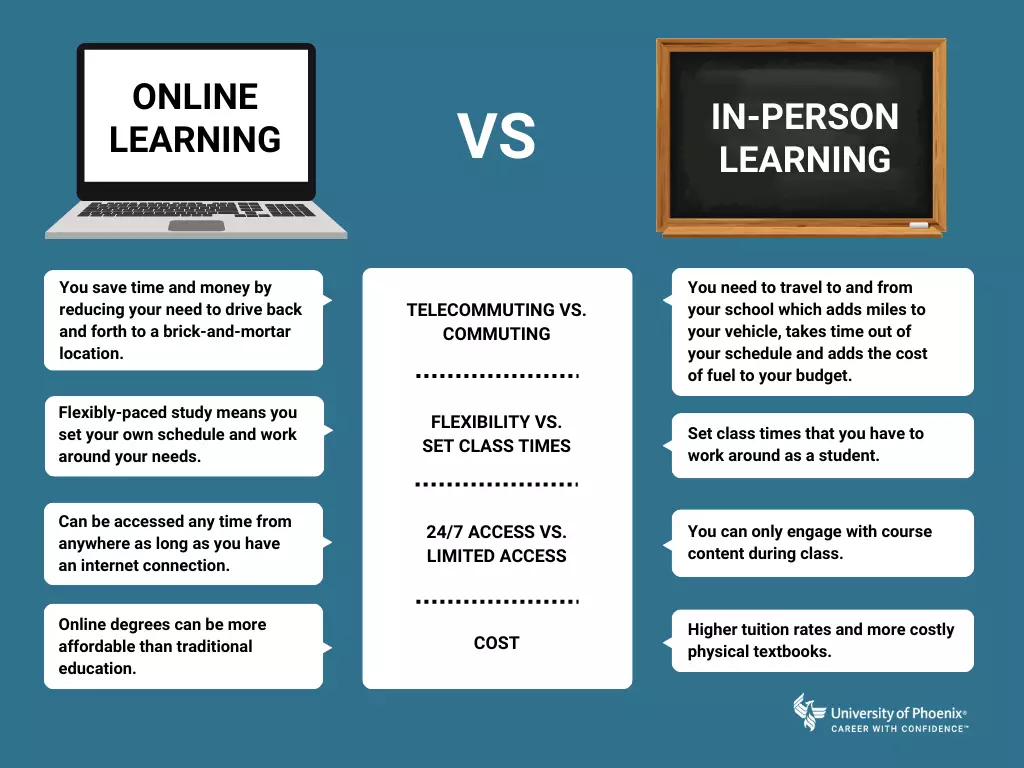
5 benefits of online learning
Online learning has a lot to offer students, but the common thread is flexibility. From the flexibly paced nature of online classes to the 24/7 access to lectures and materials, online learning prioritizes the needs of students looking to save time and money.
Let’s take a closer look at five of the key benefits.
1. Easy access to instructors and peers
As long as you have a reliable computer and internet connection, you can connect with your peers and instructors through a school’s learning portal.
Online institutions like University of Phoenix create opportunities for one-on-one connections with both instructors and peers for a learning experience that’s tailored to each student’s interests and needs. Given the online format, you can find the time in your schedule to connect for interactions that are both convenient and helpful.
read similar articles

University of Phoenix 101: Everything you need to know
2. affordability.
We’ve already touched on how learning online can be less costly than traditional higher education, but even online universities can vary in terms of affordability. The cost per college credit is only part of the equation. Some online colleges charge per credit hour, some charge per course and still others charge per semester .
University of Phoenix offers fixed tuition rates for your program, which lock in your tuition rate at enrollment. This gives students peace of mind and the ability to plan ahead because they know exactly what they’ll be paying throughout the duration of their program.
3. Enhanced work–life balance
Balancing responsibilities with work and life commitments is hard enough when you’re not a student. Taking in-person classes three or more days per week can present an entirely new challenge on top of all these things.
While both online and in-person college require timely completion of assignments, the online format allows students to learn from home. This provides a flexibility to listen to lectures or review content while the kids are at soccer practice or you’re making dinner — whenever works best for you.
4. Reasonable pacing
In addition to being able to access course assignments and information on your own schedule, some online universities, like University of Phoenix, allow students to take just one class at a time. This enables you to learn at a pace that fits into the rest of your life, which can enhance your overall retention of the course’s subject matter.

8 tips for navigating group projects
5. 24/7 availability.
The internet is always on — which means even when traditional universities are turning out the lights and locking up for the night, you can be responding to peers or faculty about the latest class discussion or completing assignments.
A huge benefit of online learning is that it’s 24/7. You can rewatch recorded lectures or access your course materials at any time. And if you missed what your instructor said, no worries. Just replay the video.
University of Phoenix and other online universities have accredited online program offerings , instructors with real-world experience and degree programs designed to cultivate value-driven skills in students. All of this — along with other benefits like University of Phoenix’s 5- or 6-week classes, fixed-rate tuition, course flexibility and lifetime career counseling — ensure that today’s students enjoy a range of advantages inherent to online learning.
When it comes to pursuing higher education, there are more options than ever. It’s just a matter of researching the pros and cons of what’s available to decide which path is your path.
If you think your work and life commitments and needs would benefit from full-time or part-time online courses, be sure to take a look at University of Phoenix’s offerings, which include degree programs in business, IT, healthcare, education and other career-focused fields of study. Certificates , which can sometimes be completed in under a year, offer relevant skills in business, technology, education and healthcare.

ABOUT THE AUTHOR
Brian Fairbanks is a freelance writer with a background in SEO content creation and blog article development.
want to read more like this?

University of Phoenix and the Future of Online College
University life.
May 21, 2024 • 8 minutes

How to Choose a Degree Program
March 29, 2024 • 5 minutes

What Does Real-World Faculty Mean?
January 18, 2024 • 5 minutes
- General Articles & Blogs
- Articles and Blogs | Online & Distance Learning UK Degrees
- Articles and Blogs
5 differences between Online Learning vs Classroom Learning
- Posted by Stafford Global
- Categories General Articles & Blogs
- Date May 13, 2020
We are now in age of the fourth industrial revolution – Technology. As it transforms major industries, life has become more interconnected, blurring the lines between the personal and professional with a growing number of sectors and companies becoming operationally mobile. The education industry has also slowly but surely attempted to accommodate these shifting demand trends, bringing with it a unique set of challenges. As Covid-19 changed the world and the education landscape with it, distance education and online learning became proliferated by necessity, raising questions about the differences between them. This articles covers the 5 differences between online learning vs classroom learning.
Online Learning vs Classroom Learning #1: Human Interaction :
The most obvious difference someone thinks of when comparing the two is the perceived lack of human interaction, however this isn’t technically true. The correct way to phrase this would be ‘no physical interaction’. Classroom Learning involves physical interactions with a teacher and peers, while online learning transfers this component to a virtual environment. So while there is human interaction, it happens online via virtual lectures, virtual discussions, face-to-face video workshops etc.
Online Learning vs Classroom Learning #2: 24/7 access to learning materials :
With online courses, students can always access learning materials such as module contents, assignments, lecture materials, podcasts and recorded sessions anytime during the course of their studies. For postgraduate courses module tutors are always there to assist with any questions through emails, messages and Skype calls. With Classroom Learning, be it for a school or university courses, a student has to visit the physical location to speak with tutors face to face, during assigned hours. This can be limiting, especially for working professionals.
Online Learning vs Classroom Learning #3: Practice while you study :
For University courses, Online Learning students can fit studies around their work schedules, and can immediately practice new concepts learned by applying them in their current scope of work. With classroom learning university courses, this is not often the case. Since students have to leave their job and social commitments to complete a degree programme, they will only be able to practice the new knowledge once they have re-joined the workforce. When it comes to schools and younger learners, a lot of Online Learning tools and apps help students understand concepts on a deeper level by providing problems they can interact and solve with in different ways. For example, logic puzzles or math puzzles that aren’t the cut and dry ‘solve for x’ prevalent in classroom learning.
Online Learning vs Classroom Learning #4: Assessments :
The Classroom Learning method of assessing a student’s capabilities is usually through quizzes and exams, most often one in a physical setting invigilated by an examiner. Covid-19 has made this method of assessment (temporarily) redundant. In Online Learning, assessments are undertaken via assignments, which can be either individual or group-based, providing an opportunity for students to form study groups that support each other and learn from their differing experiences. In rarer cases, online, open-book exams are also used as an assessment medium, however the latter is more popular.
Online Learning vs Classroom Learning #5: Agility :
Course materials can be accessed from anywhere in the world, regardless of differences in time zones, the location of the student, or their current status. From a busy working professional studying online in the late hours of the evening, to a stay at home mum brushing up their knowledge before getting back on the job market, online learning provides the much needed flexibility to study and finish a degree at each one’s own pace.
As universities recognise the need of the modern workforce for education, learning and development, online programmes were developed with various specialisations to cater to professionals from different fields, industries and experiential backgrounds. It is no longer an absolute requirement to travel to a campus to study the programme, as our partner UK universities have a global reach, providing their distance learning courses to various countries worldwide.
The online mode of learning also inculcates a sense of discipline amongst students as they have to be self-motivated to finish their assignments and degree requirements to graduate on time. With student support always available to online students, they are guaranteed to successfully finish their degree course with a little commitment and dedication. At Stafford, we endeavour to assist students with choosing the right programme and help them successfully apply in joining thousands of students, all studying the same qualification worldwide.
Tag: Online Learning , Online Masters Degrees
Previous post
10 Reasons Online Learning in Education should be the new normal
6 teaching tips to build healthier teacher-student relationships, you may also like, are mba specialisations worth the focus or just a distraction, do prestigious universities still have any role in the internet age, what’s the difference between online learning and distance learning, stafford global, privacy overview.
We use cookies on our website to support technical features that enhance your user experience, and to help us improve our website. By continuing to use this website, you accept our privacy policy .
- Student Login
- No-Cost Professional Certificates
- Call Us: 888-549-6755
- 888-559-6763
- Search site Search our site Search Now Close
- Request Info
Skip to Content (Press Enter)
Online vs. Traditional Education: What You Need to Know
By Will Erstad on 08/16/2017

The word “college” might make you think of students hanging out in dorm rooms or gathering for classes in enormous lecture halls. But that depiction is becoming increasingly out-of-date as technology provides for more and more ways to learn.
In fact, online and distance learning has steadily grown in popularity among college students, but does that mean it’s a good choice for you? In order to help you answer that question, take some time to compare and contrast traditional versus online education.
Comparing online versus traditional education
Both online education and its traditional counterpart have pros and cons, so it’s important for students to understand what to expect before they step foot—or log into—the classroom. We focused this side-by-side comparison on three key areas that make an impact on a student’s experience. We’ll also take a closer look at what a “blended learning” model has to offer.
Online vs. traditional education: Flexibility
One of the key components to consider when weighing the options is the amount of time you have every day to dedicate to schoolwork. Are you willing and able to attend college full-time or do you need more flexibility to work around your busy schedule?
Online education:
A benefit to taking online courses is that they offer flexibility to the student. This is a great option for those who already have time commitments with family and work. Online classes will mold with your schedule—and allow you to log into your online course at a time that works best for you, as opposed to having to attend a lecture at a specific time.
Most online courses will follow a weekly format where students are expected to log in, read course materials, contribute to online class discussions and complete assignments prior to the beginning of the next week. You’ll still have plenty to do for each class—but you’ll have more options for fitting this work in around other commitments.
Traditional education:
Generally speaking, this is the best option for students who have a little more freedom in their schedules. That said, traditional students do have some flexibility in their scheduling in that some schools offer night classes or classes that follow a schedule where they meet only once per week.
One easy-to-overlook factor when it comes to scheduling is travel time to campus—a long commute can certainly make schedules difficult, especially if you’re planning on working while in school .
Online vs. traditional education: Discipline & self-motivation
Something else to consider while weighing your college options is your level of self-discipline. Both traditional and online education certainly require some discipline to succeed, but there can be significant differences in how learning is structured. These structural differences can have a significant effect on your ability to stay on track.
The increased flexibility of online learning comes with a bit of a trade-off—you’ll need to be highly self-motivated. All college classes require students to keep up on required reading and assignments, but some students may struggle to stay motivated when learning from the comfort of their home.
The best online students develop strategies for staying up to date on their coursework. Things like setting aside time every week for studying and creating a work space with minimal distractions can help immensely.
When it comes to discipline and motivation, traditional education does have an advantage in the eyes of many. The structured schedule of attending class a handful of times per week and having routine face-to-face interactions with instructors can help keep students on task. Students in traditional, on-campus settings have more opportunities to be reminded of upcoming assignments, which can help if you tend to procrastinate on large, time-consuming assignments.
Online vs. traditional education: Social interaction
One final area to consider is the level of social interaction you’re hoping to have as you earn your degree. Do you need interaction from your peers and instructors to succeed and stay motivated? Or do you thrive in an independent study environment?
Social interaction with instructors and other students, while not as common in online courses, still happens regularly. The biggest difference is in the form it takes, with many online student interactions happening via video chat or through online discussion posts.
Some courses may also offer pre-recorded videos of the same lectures given to traditional, on-campus students. If you’re a social learner who likes to ask questions and pick the brains of your instructors, these video lectures can help you earn a deeper understanding of assigned reading materials.
Despite technological advances, traditional education is still likely the better option for those who thrive on face-to-face communication. Seeing and interacting with your instructors on a regular basis can be motivating for some—it’s a little easier to go the extra mile if you know your instructor is likeable and invested in your education. Traditional, in-class settings may also offer more opportunities for spur-of-the-moment questioning or interesting tangents that may help a concept “click” in the minds of students.
Online vs. traditional education: The blended education model
By now, it’s probably becoming clear to you that both online and traditional education each have their perks. So is there a way to get the best of both worlds? One option that is increasing in popularity is called “blended learning.”
In this format, curriculum is designed to implement both traditional, in-person learning and online coursework. The implementation of this can vary greatly, depending on the subject and instructor. But as an example, instructors may require only meeting once weekly for lectures, while assigning projects or other activities for students to complete online on their own time. This allows students to receive some of the positives from face-to-face social learning while still allowing for scheduling flexibility.
Another example would be a program that offers some courses on campus and others online. For example, a nursing program may include an online anatomy course, and a nursing simulation lab on campus. The idea here is that certain courses involve material that is conducive to online learning, while other lessons can only be taught in a physical classroom or lab.
The decision is yours
In the case of online versus traditional education, there is no right or wrong answer. Much of it comes down to personal preference and knowing how you learn best. These learning formats can all be very effective, no matter your personal learning style and situation.
Ready to get started with a new college experience? Find a campus location near you or check out the online program offerings of Rasmussen University.
EDITOR’S NOTE: This article was originally published February 2014 and has been updated to reflect information from 2017.
- Share on Facebook
- Share on Twitter
- Share on Pinterest
- Share on LinkedIn
Request More Information
Talk with an admissions advisor today. Fill out the form to receive information about:
- Program Details and Applying for Classes
- Financial Aid and FAFSA (for those who qualify)
- Customized Support Services
- Detailed Program Plan
There are some errors in the form. Please correct the errors and submit again.
Please enter your first name.
Please enter your last name.
There is an error in email. Make sure your answer has:
- An "@" symbol
- A suffix such as ".com", ".edu", etc.
There is an error in phone number. Make sure your answer has:
- 10 digits with no dashes or spaces
- No country code (e.g. "1" for USA)
There is an error in ZIP code. Make sure your answer has only 5 digits.
Please choose a School of study.
Please choose a program.
Please choose a degree.
The program you have selected is not available in your ZIP code. Please select another program or contact an Admissions Advisor (877.530.9600) for help.
The program you have selected requires a nursing license. Please select another program or contact an Admissions Advisor (877.530.9600) for help.
Rasmussen University is not enrolling students in your state at this time.
By selecting "Submit," I authorize Rasmussen University to contact me by email, phone or text message at the number provided. There is no obligation to enroll. This site is protected by reCAPTCHA and the Google Privacy Policy and Terms of Service apply.
About the author
Will Erstad
Will is a Sr. Content Specialist at Collegis Education. He researches and writes student-focused articles on a variety of topics for Rasmussen University. He is passionate about learning and enjoys writing engaging content to help current and future students on their path to a rewarding education.

Posted in Online Learning
- online learning tips
Related Content

Carrie Mesrobian | 06.06.2022

Will Erstad | 08.12.2021

Carrie Mesrobian | 04.12.2021

Will Erstad | 10.05.2020
This piece of ad content was created by Rasmussen University to support its educational programs. Rasmussen University may not prepare students for all positions featured within this content. Please visit www.rasmussen.edu/degrees for a list of programs offered. External links provided on rasmussen.edu are for reference only. Rasmussen University does not guarantee, approve, control, or specifically endorse the information or products available on websites linked to, and is not endorsed by website owners, authors and/or organizations referenced. Rasmussen University is accredited by the Higher Learning Commission, an institutional accreditation agency recognized by the U.S. Department of Education.
Home — Essay Samples — Education — Educational System — Online Vs. Traditional Classes
Essays on Online Vs. Traditional Classes
What makes a good online vs. traditional classes essay topics.
When it comes to writing an essay comparing online versus traditional classes, choosing the right topic is essential. A good essay topic should be thought-provoking, relevant, and engaging. It should allow for a thorough analysis of the subject matter and provide the writer with enough material to support their arguments. Here are some recommendations on how to brainstorm and choose an essay topic, what to consider, and What Makes a Good essay topic.
To brainstorm and choose an essay topic for an Online Vs. Traditional Classes essay, start by considering your personal interests and experiences. Reflect on your own experiences with both online and traditional classes and think about any issues, challenges, or advantages you may have encountered. This can help you identify potential topics that are relevant and meaningful to you.
Next, consider the current trends and debates in the field of education. Look for topics that are hotly debated or have conflicting viewpoints. These topics are likely to generate interest and provide ample material for analysis and argumentation.
Additionally, it is important to consider the scope of the topic. A good essay topic should be specific enough to allow for in-depth analysis but broad enough to encompass various aspects of the subject matter. Avoid choosing topics that are too broad or too narrow, as they can be difficult to explore in a comprehensive manner.
Lastly, a good essay topic should be relevant and timely. Consider the current state of education and the impact of technology on the learning process. Look for topics that address the evolving nature of education and the challenges and opportunities presented by online and traditional classes.
Best Online Vs. Traditional Classes Essay Topics
When it comes to writing an essay comparing online versus traditional classes, there are numerous creative and engaging topics to choose from. Here are some of the best essay topics that stand out and provide ample material for analysis and argumentation:
- The impact of online education on student engagement and motivation.
- The role of technology in shaping the future of education.
- The effectiveness of online learning in promoting student success.
- The challenges and opportunities of transitioning from traditional to online classes.
- The potential of blended learning approaches in enhancing student learning outcomes.
- The importance of teacher-student interaction in online and traditional classes.
- The benefits and drawbacks of online versus traditional classes for adult learners.
- The impact of online education on the development of critical thinking skills.
- The role of digital literacy in online learning environments.
- The influence of socio-economic factors on access to online education.
- The relevance of traditional teaching methods in the digital age.
- The potential of virtual reality in enhancing the online learning experience.
- The impact of online education on the accessibility of higher education.
- The challenges of maintaining academic integrity in online learning environments.
- The role of peer interaction in online and traditional classes.
- The influence of learning preferences on the effectiveness of online versus traditional classes.
- The potential of gamification in online education.
- The impact of online education on student well-being and mental health.
- The importance of personalized learning in online and traditional classes.
- The future of education: trends and challenges in online and traditional classes.
These essay topics are not only relevant and thought-provoking but also provide ample material for analysis and argumentation. They address the evolving nature of education and the impact of technology on the learning process, making them ideal for a compelling Online Vs. Traditional Classes essay.
Online Vs. Traditional Classes essay topics Prompts
Are you struggling to come up with a creative and engaging essay topic for an Online Vs. Traditional Classes essay? Here are five prompts to spark your creativity and inspire your writing:
- Imagine a world where online education is the norm. How would this impact the traditional classroom experience?
- In what ways does online education challenge the traditional model of education? What are the potential benefits and drawbacks of this shift?
- Reflect on your own experiences with online and traditional classes. How do they compare in terms of student engagement, learning outcomes, and overall experience?
- Consider the role of technology in shaping the future of education. How does this impact the effectiveness of online versus traditional classes?
- Explore the potential of blended learning approaches in promoting student success. What are the challenges and opportunities presented by this approach?
These prompts are designed to encourage critical thinking and reflection on the topic of Online Vs. Traditional Classes. They offer a creative and engaging starting point for developing a compelling essay that stands out. So, go ahead and let your imagination run wild as you explore these thought-provoking prompts!
The Importance of The Jesuits
The value of online education, made-to-order essay as fast as you need it.
Each essay is customized to cater to your unique preferences
+ experts online
Online Education Vs In-class Education: a Comprehensive Analysis
Online school vs traditional school, online vs. traditional classes: examining both sides of the debate, similarities and differences between online and traditional classes, let us write you an essay from scratch.
- 450+ experts on 30 subjects ready to help
- Custom essay delivered in as few as 3 hours
Comparison of Online Learning and Traditional Classes
How online classes are less effective than regular classroom classes, the advantages of online classes over the traditional ones, online education and its benefits: detailed analysis, get a personalized essay in under 3 hours.
Expert-written essays crafted with your exact needs in mind
Technology & Innovation in Education: Web Based Learning
Comparative analysis of traditional learning and online classes, online vs traditional classes: is one more effective than the other, the benefits of taking online classes for college students, review of education priority, online education and education in indiana state, implementing online classes instead of the traditional classes, 10 minute school - one of the largest and best online education platforms, online education in the usa, online education - a boon for military, effective online assessment and evaluation though online laboratory submission, psychometric analysis of the indonesian version of the online learning readiness scale using generalized partial credit model, it's not for everyone: pros and cons of distance learning, should school switch to electronic textbook to save money and paper, new reality: online distance learning in philippines, effectiveness and positive impact of online classes on students, online vs in person classes: a paradigm shift in education, online learning vs face-to-face, advantages and disadvantages of hybrid learning, the evolution of online learning, innovatory education: a paradigm shift in learning approaches.
Online and classroom-based education are two different types of learning. Although both offer high-quality learning, each has its own teaching method and establishes its own channels and guidelines for learning. Online education uses the Internet and information and communications technology (ITC), making courses dynamic, intuitive and easy to follow. While with classroom-based learning, students go to a physical classroom where the teaching and much of the learning takes place.
Online system enables students to attend classes, work, communicate, take exams and access content wherever they may be. It stimulates students' independence and curiosity, collaborative work, critical thinking and self-directed learning. This system also diversifies sources of knowledge. With traditional method, the students take a more passive role and adapt to the teacher's rhythm and teaching method. Students have a closer relationships with their teachers and an opportunity to socialise.
Relevant topics
- Middle School
- High School
- Homeschooling
- Single Sex Schools
- Extracurricular Activities
- Academic Challenges
- Academic Interests
- Stem Education
- Physical Education
- School Uniform
By clicking “Check Writers’ Offers”, you agree to our terms of service and privacy policy . We’ll occasionally send you promo and account related email
No need to pay just yet!
We use cookies to personalyze your web-site experience. By continuing we’ll assume you board with our cookie policy .
- Instructions Followed To The Letter
- Deadlines Met At Every Stage
- Unique And Plagiarism Free
to Compare and Contrast Online Learning & Classroom learning
Unauthorized use and/or duplication of this material without express and written permission from this site’s author and/or owner is strictly prohibited. Excerpts and links may be used, provided that full and clear credit is given to Writing9 with appropriate and specific direction to the original content.
Fully explain your ideas
To get an excellent score in the IELTS Task 2 writing section, one of the easiest and most effective tips is structuring your writing in the most solid format. A great argument essay structure may be divided to four paragraphs, in which comprises of four sentences (excluding the conclusion paragraph, which comprises of three sentences).
For we to consider an essay structure a great one, it should be looking like this:
- Paragraph 1 - Introduction
- Sentence 1 - Background statement
- Sentence 2 - Detailed background statement
- Sentence 3 - Thesis
- Sentence 4 - Outline sentence
- Paragraph 2 - First supporting paragraph
- Sentence 1 - Topic sentence
- Sentence 2 - Example
- Sentence 3 - Discussion
- Sentence 4 - Conclusion
- Paragraph 3 - Second supporting paragraph
- Paragraph 4 - Conclusion
- Sentence 1 - Summary
- Sentence 2 - Restatement of thesis
- Sentence 3 - Prediction or recommendation
Our recommended essay structure above comprises of fifteen (15) sentences, which will make your essay approximately 250 to 275 words.
Discover more tips in The Ultimate Guide to Get a Target Band Score of 7+ » — a book that's free for 🚀 Premium users.
- Check your IELTS essay »
- Find essays with the same topic
- View collections of IELTS Writing Samples
- Show IELTS Writing Task 2 Topics
Learning English at school is often seen as more important than learning local languages. If these are not taught, many are at risk of dying out. In your opinion is it important for everyone to learn English? Should we try to ensure the survival of languages? And if so how? Give reasons for your answers and give relevant examples.
The number of overweight and unhealthy children in developed country is increasing, and many people think that this is linked to diet and lifestyle. what are the reasons for this increase and what can be done to reduce the problem, many small, local shops are closing as they are unable to compete with large supermarkets in the area. how does this effect local communities how could this situation be improved, a knowledge of maths is not important for most jobs nowadays. to what extent do you agree or disagree with this statement, youth drug abuse is a serious problem. what are the possible causes of this behavior do you have any suggestion to control that.

IMAGES
VIDEO
COMMENTS
The article compares and contrasts online classes and traditional classes. Among the advantages of online classes are flexibility and convenience, while in-person classes offer a more structured learning environment. The author highlights that online lessons can be more cost-effective, although they lack support provided by live interactions.
King University describes technostress as "a modern disease of adaptation caused by an inability to cope with new technologies in a healthy manner.". Technostress can lead to difficulty concentrating, inability to relax, low confidence, and difficulty sleeping. Essentially, technology can lead to symptoms of anxiety.
It allows learners to study at their own pace and on their schedule, making it an ideal option for those with busy lifestyles or other commitments. 2. Cost-Effective. Online courses are often less expensive than traditional classroom-based courses, making education more accessible to a wider range of learners. 3.
A Comparison of Student Learning Outcomes: Online Education vs. Traditional Classroom Instruction. Despite the prevalence of online learning today, it is often viewed as a less favorable option when compared to the traditional, in-person educational experience. Criticisms of online learning come from various sectors, like employer groups ...
Online learning also costs less than traditional classroom-based experiences. A recent study by education analyst Ed Vosganian found that an undergraduate online degree could cost 50% less than an undergraduate on-campus course. Using statistics from a school in Florida, the study found that campus learning can cost $42,768 per year, whilst ...
3. 📌Published: 12 February 2022. Over the year 2020, virtual learning has become the standard for most schools. It may be convenient, but it isn't the best way students should be learning. Traditional Classes are easily more effective. Traditional classes are more effective than online classes because they increase attendance, improve test ...
A: Online learning can be as good or even better than in-person classroom learning. Research has shown that students in online learning performed better than those receiving face-to-face instruction, but it has to be done right. The best online learning combines elements where students go at their own pace, on their own time, and are set up to ...
The authors explained that modern technology can help societies to adapt and overcome these negative effects. In our study, university students' performance in online learning during the COVID-19 pandemic was better that than during traditional learning. Classroom activity positively was shown to affect student overall performance.
While traditional classroom learning offers face-to-face interaction with teachers and peers, eLearning provides flexibility and convenience for learners. It ultimately depends on the individual's preferences and needs when it comes to choosing between the two. However, in today's digital age, incorporating elements of both methods can result ...
In conclusion, both online learning and classroom learning offer unique advantages and disadvantages. Online learning provides flexibility and access to a wide range of resources, while classroom learning offers immediate feedback and a sense of community. The choice between these two modes of learning ultimately depends on individual ...
At the same time, despite the rising popularity of online courses, traditional (classroom) training is fighting back and trying to adopt newer means of retaining learners' interest. There are always two sides of a coin. For some individuals, online training is more appropriate, while for others classroom training is the preferred delivery method.
There are many factors to consider when determining which style of learning will fit you. Online learning has grown significantly since the COVID-19 pandemic, leading more students to embrace it. Find out more about online vs. classroom education, what factors to consider, and how to choose. What to Consider When Weighing Online vs. Classroom ...
The article discusses challenges of effective learning in classroom and online environments from the student perspective. The aim of the study is to analyse university students' perception of ...
5 benefits of online learning. Online learning has a lot to offer students, but the common thread is flexibility. From the flexibly paced nature of online classes to the 24/7 access to lectures and materials, online learning prioritizes the needs of students looking to save time and money. Let's take a closer look at five of the key benefits. 1.
In a broader sense, online learning, also commonly referred to as e-learning, may encompass any form of non-traditional classroom-based learning. Hence, researchers have alluded to online learning as computer-assisted learning, distance education, virtual learning, and web-based learning, among others ( Blake, 2011 ; Easton, 2003 ; Huang, 2017 ...
Online learning delivers the content through text, images, or videos, and the students are asked to complete an online assessment or other activities. The teaching can be set at any specific time, but there's limited interaction. On the other hand, traditional learning has a fixed schedule and place.
Online Learning vs Classroom Learning #2: 24/7 access to learning materials: With online courses, students can always access learning materials such as module contents, assignments, lecture materials, podcasts and recorded sessions anytime during the course of their studies. For postgraduate courses module tutors are always there to assist with ...
Based on the criteria outlined above, online learning is a more effective and accessible form of education than traditional classroom learning. Online learning is more effective than traditional classroom learning because it allows students to access a wider range of learning materials and resources.
Thus, both online and traditional learning will have performance and quality depending on individual student's comprehension. Works Cited. Martz, J. (2017). Online vs. Traditional Learning: What are the Differences?. Arizona Christian University. Leaf Group Education. (2021). Online vs. Traditional Education. Classroom. University of the ...
Rasmussen University is accredited by the Higher Learning Commission, an institutional accreditation agency recognized by the U.S. Department of Education. When weighing whether to take online courses versus in a traditional classroom setting, there's a lot to consider.
In this brief compare and contrast essay, a student compares online classes to traditional classes. The student focuses on scheduling as well as communication with the teacher in each context. This essay received a B by one of Kibin's paper graders. Click here to see what was done well and what needs improvement.
1 page / 569 words. Hybrid learning, a combination of traditional classroom instruction and online education, has gained prominence as an alternative educational model. The Advantages and Disadvantages of Hybrid Learning Essay delves into the benefits and drawbacks of this approach.
For instance. , when they study online, they have to learn five units per semester and when they have to stay at home, they still have to learn five units, too. On the contrary. , one of the notable differences between learning online and learning onsite is that studying online will make them have fewer conversations with their. teachers.